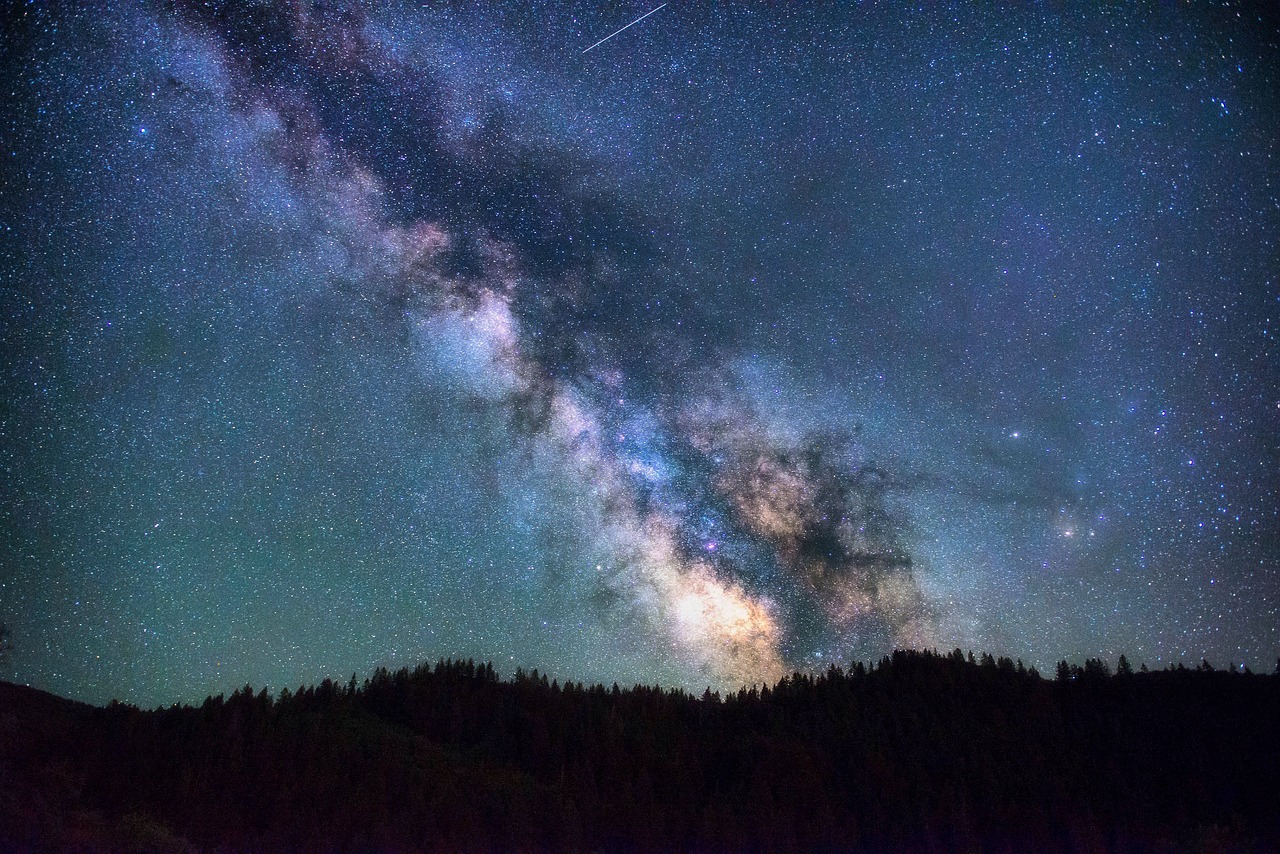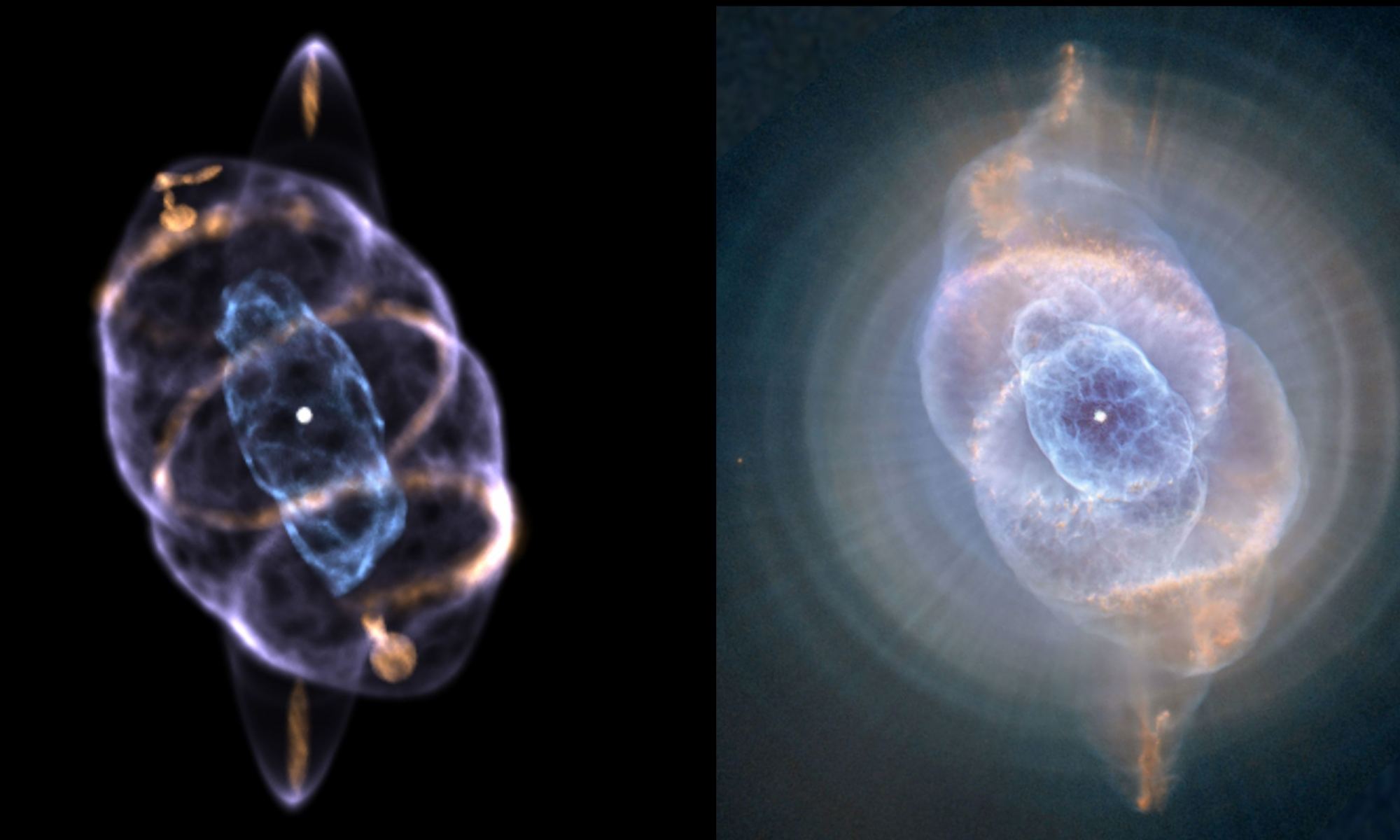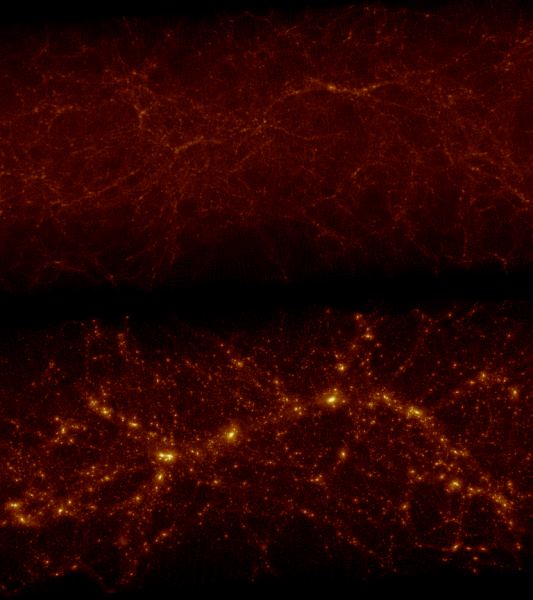At least once, you’ve looked up at the night sky and asked the same longstanding question we’ve all asked at least once, “Are we alone?” With all those points of light out there, we can’t be the only intelligent beings in the universe, right? There must be at least one technological civilization aside from us in the great vastness that we call the cosmos.
Continue reading “What if we’re truly alone?”Why ‘Contact’ still resonates after 25 years

25 years ago, the film Contact made its theatrical debut starring Jodie Foster and Matthew McConaughey and told the story of Dr. Eleanor Arroway (Jodie Foster) who picked up a radio signal from the star Vega and how this discovery impacted not just herself, but humanity as a whole. Over time, she discovers the signal has embedded instructions sent by the aliens to build a device capable of sending one person into outer space, presumably to meet the Vegans.
Continue reading “Why ‘Contact’ still resonates after 25 years”Astronomers Simulate the Cat’s Eye Nebula in 3D
In a recent study published in Monthly Notices of the Royal Astronomical Society, an international team of researchers led by Stanford University have produced the first computer-generated 3D model of the Cat’s Eye Nebula, which unveiled a symmetric pair of rings that enclose the outer shell of the nebula. This study holds the potential for helping us better understanding the nebula’s makeup and how it formed, as the symmetric rings provides clues that they were formed from a precessing jet, which produces strong confirmation that a binary star exists at the nebula’s center.
Continue reading “Astronomers Simulate the Cat’s Eye Nebula in 3D”The Record for the Farthest Galaxy just got Broken Again, now just 250 million years after the Big Bang
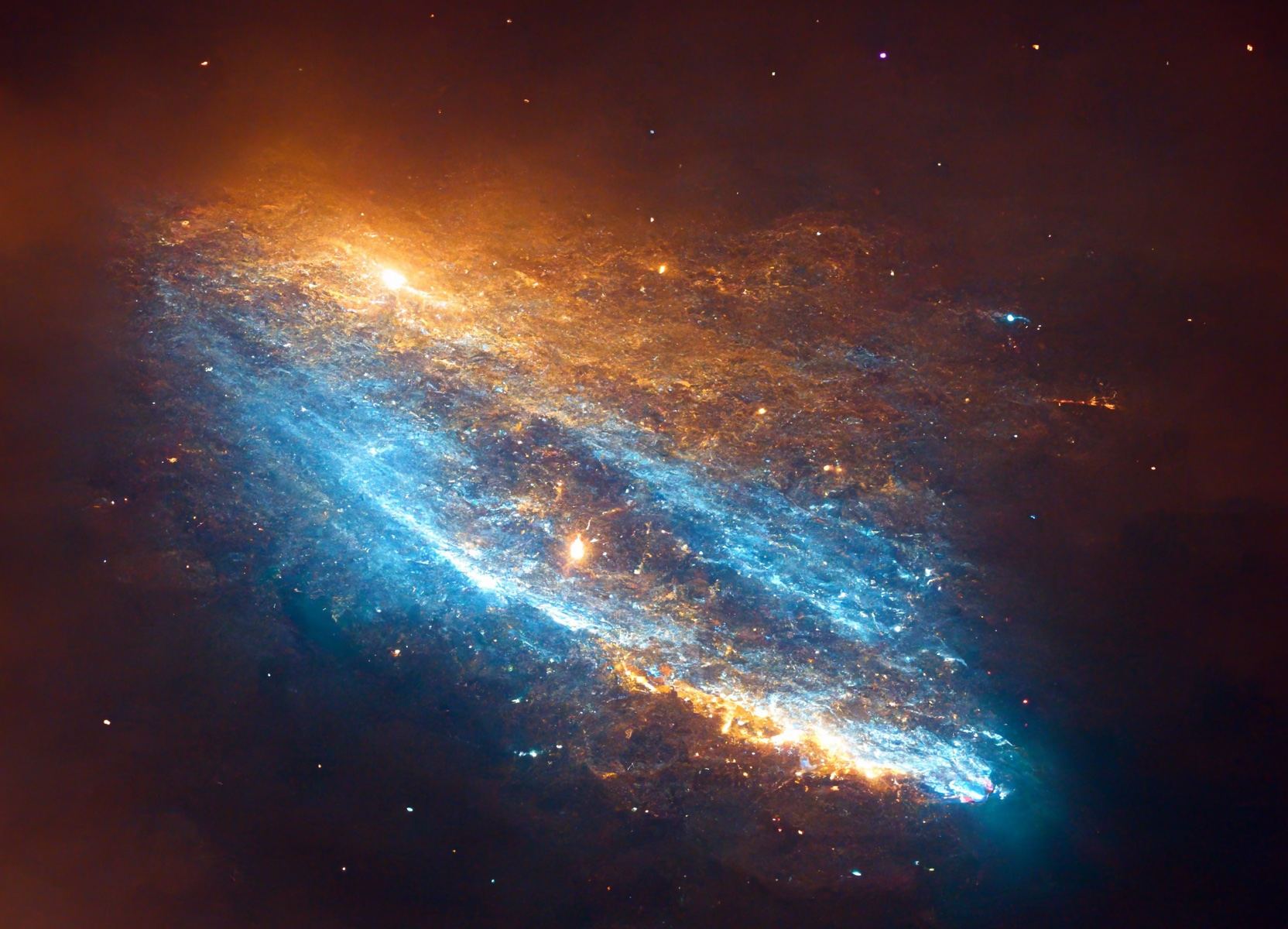
In a recent study submitted to MNRAS, a collaborative research team has utilized the first set of data from the James Webb Space Telescope (JWST) discovering a galaxy candidate, CEERS-93316, that formed approximately 250 million years after the Bing Bang, which also set a new redshift record of z = 16.7. This finding is extremely intriguing as it demonstrates the power of JWST, which only started sending back its first set of data a few weeks ago. CEERS stands for Cosmic Evolution Early Release Science Survey, and was specifically created for imaging with JWST.
Continue reading “The Record for the Farthest Galaxy just got Broken Again, now just 250 million years after the Big Bang”Another Amazing Image from Webb, This Time it’s Galaxy IC 5332
The James Webb Space Telescope (JWST) continues to both dazzle and amaze with its latest image, this time of Galaxy IC 5332, also known as PGC 71775, which is an intermediate spiral galaxy located approximately 30 million light years away. This comes after JWST released its first images at its full power, which includes the Carina Nebula, Stephan’s Quintet, Southern Ring Nebula, and SMACS 0723, the last of which was the deepest and sharpest image of the distant universe to date.
Continue reading “Another Amazing Image from Webb, This Time it’s Galaxy IC 5332”These Galaxies are Definitely Living in a Simulation
Studying the universe is hard. Really hard. Like insanely, ridiculously hard. Think of the hardest thing you’ve ever done in your life, because studying the universe is quite literally exponentially way harder than whatever you came up with. Studying the universe is hard for two reasons: space and time. When we look at an object in the night sky, we’re looking back in time, as it has taken a finite amount of time for the light from that object to reach your eyes. The star Sirius is one of the brightest objects in the night sky and is located approximately 8.6 light-years from Earth. This means that when you look at it, you’re seeing what it looked like 8.6 years ago, as the speed of light is finite at 186,000 miles per second and a light year is the time it takes for light to travel in one year. Now think of something way farther away than Sirius, like the Big Bang, which supposedly took place 13.8 billion years ago. This means when scientists study the Big Bang, they’re attempting to look back in time 13.8 billion years. Even with all our advanced scientific instruments, it’s extremely hard to look back that far in time. It’s so hard that the Hubble Space Telescope has been in space since 1990 and just recently spotted the most distant single star ever detected in outer space at 12.9 billion light-years away. That’s 30 years of scanning the heavens, which is a testament to the vastness of the universe, and hence why studying the universe is hard. Because studying the universe is so hard, scientists often turn to computer simulations, or models, to help speed up the science aspect and ultimately give us a better understanding of how the universe works without waiting 30 years for the next big discovery.
Continue reading “These Galaxies are Definitely Living in a Simulation”Is the Universe a Fractal?

We find examples of fractals everywhere in nature. Tree branches, snowflakes, river deltas, cloud formations, and more. So it’s natural to ask the ultimate question: is the entire universe one giant fractal? The answer is…no, but sorta yes.
Continue reading “Is the Universe a Fractal?”The Oldest Stars Help Tell us how big the Universe is

Astronomers are struggling to understand the discrepancies when measuring the expansion rate of the universe with different methods, and are desperate for any creative idea to break the tension. A new method involving some of the oldest stars in the universe could just do the trick.
Continue reading “The Oldest Stars Help Tell us how big the Universe is”Simulations of the Universe are Getting Better and Better at Matching Reality

How can you possibly use simulations to reconstruct the history of the entire universe using only a small sample of galaxy observations? Through big data, that’s how.
Continue reading “Simulations of the Universe are Getting Better and Better at Matching Reality”What Is the Name Of Our Galaxy?

Since prehistoric times, human beings have looked up at at the night sky and pondered the mystery of the band of light that stretches across the heavens. And while theories have been advanced since the days of Ancient Greece as to what it could be, it was only with the birth of modern astronomy that scholars have come come to know precisely what it is – i.e. countless stars at considerable distances from Earth.
The term “Milky Way”, a term which emerged in Classical Antiquity to describe the band of light in the night sky, has since gone on to become the name for our galaxy. Like many others in the known Universe, the Milky Way is a barred, spiral galaxy that is part of the Local Group – a collection of 54 galaxies. Measuring 100,000 – 180,000 light-years in diameter, the Milky Way consists of between 100 and 400 billion stars.
Structure:
The Milky Way consists of a Galactic Center that is shaped like a bar and a Galactic Disk made up of spiral arms, all of which is surrounded by the Halo – which is made up of old stars and globular clusters. The Center, also known as “the bulge”, is a dense concentration of mostly old stars that measures about 10,000 light years in radius. This region is also the rotational center of the Milky Way.
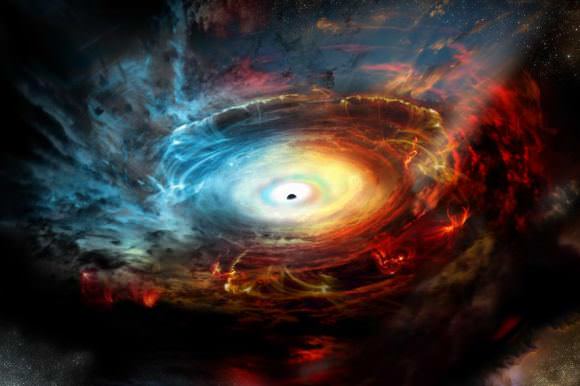
The Galactic Center is also home to an intense radio source named Sagittarius A*, which is believed to have a supermassive black hole (SMBH) at its center. The presence of this black hole has been discerned due to the apparent gravitational influence it has on surrounding stars. Astronomers estimate that it has a mass of between 4.1. and 4.5 million Solar masses.
Outside the barred bulge at the Galactic Center is the Galactic Disk of the Milky Way. This consists of stars, gas and dust which is organized into four spiral arms. These arms typically contain a higher density of interstellar gas and dust than the Galactic average, as well as a greater concentration of star formation. While there is no consensus on the exact structure or extent of these spiral arms, they are commonly grouped into two or four different arms.
In the case of four arms, this is based on the traced paths of gas and younger stars in our galaxy, which corresponds to the Perseus Arm, the Norma and Outer Arm, the Scutum-Centaurum Arm, and the Carina-Sagittarius Arm. There are also at least two smaller arms, which include the Cygnus Arm and the Orion Arm. Meanwhile, surveys based on the presence of older stars show only two major spirals arms – the Perseus arm and the Scutum–Centaurus arm.
Beyond the Galactic Disk is the Halo, which is made up of old stars and globular clusters – 90% of which lie within 100,000 light-years (30,000 parsecs) from the Galactic Center. Recent evidence provided by X-ray observatories indicates that in addition to this stellar halo, the Milky way also has a halo of hot gas that extends for hundreds of thousands of light years.
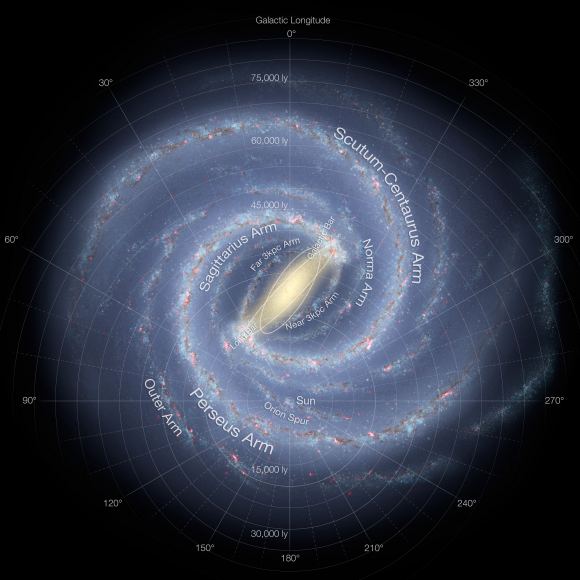
Size and Mass:
The Galactic Disk of the Milky Way Galaxy is approximately 100,000 light years in diameter and about 1,000 light years thick. It is estimated to contain between 100 and 400 billion stars, though the exact figure depends on the number of very low-mass M-type (aka. red dwarf) stars. This is difficult to determine because these stars also have low-luminosity compared to other class.
The distance from the Sun to the Galactic Center is estimated to be between 25,000 to 28,000 light years (7,600 to 8,700 parsecs). The Galactic Center’s bar (aka. its “bulge”) is thought to be about 27,000 light-years in length and is composed primarily of red stars, all of which are thought to be ancient. The bar is surrounded by the ‘5-kpc ring’, a region that contains much of the galaxy’s molecular hydrogen and where star-formation is most intense.
The Galactic Disk has a diameter of between 70,000 and 100,000 light-years. It does not have a sharp edge, a radius beyond which there are no stars. However, the number of stars drops slowly with distance from the center. Beyond a radius of roughly 40,000 light years, the number of stars drops much faster the farther you get from the center.
Location of the Solar System:
The Solar System is located near the inner rim of the Orion Arm, a minor spiral arm located between the Carina–Sagittarius Arm and the Perseus Arm. This arm measures some 3,500 light-years (1,100 parsecs) across, approximately 10,000 light-years (3,100 parsecs) in length, and is at a distance of about 25,400 to 27,400 light years (7.78 to 8.4 thousand parsecs) from the Galactic Center.
History of Observation:
Our galaxy was named because of the way the haze it casts in the night sky resembled spilled milk. This name is also quite ancient. It is translation from the Latin “Via Lactea“, which in turn was translated from the Greek for Galaxias, referring to the pale band of light formed by stars in the galactic plane as seen from Earth.
Persian astronomer Nasir al-Din al-Tusi (1201–1274) even spelled it out in his book Tadhkira: “The Milky Way, i.e. the Galaxy, is made up of a very large number of small, tightly clustered stars, which, on account of their concentration and smallness, seem to be cloudy patches. Because of this, it was likened to milk in color.”
Astronomers had long suspected the Milky Way was made up of stars, but it wasn’t proven until 1610, when Galileo Galilei turned his rudimentary telescope towards the heavens and resolved individual stars in the band across the sky. With the help of telescopes, astronomers realized that there were many, many more stars in the sky, and that all of the ones that we can see are a part of the Milky Way.
In 1755, Immanuel Kant proposed that the Milky Way was a large collection of stars held together by mutual gravity. Just like the Solar System, this collection would be rotating and flattened out as a disk, with the Solar System embedded within it. Astronomer William Herschel (discoverer of Uranus) tried to map its shape in 1785, but he didn’t realize that large portions of the galaxy are obscured by gas and dust, which hide its true shape.
It wasn’t until the 1920s, when Edwin Hubble provided conclusive evidence that the spiral nebulae in the sky were actually whole other galaxies, that the true shape of our galaxy was known. Thenceforth, astronomers came to understand that the Milky Way is a barred, spiral galaxy, and also came to appreciate how big the Universe truly is.
The Milky Way is appropriately named, being the vast and cloudy mass of stars, dust and gas it is. Like all galaxies, ours is believed to have formed from many smaller galaxies colliding and combining in the past. And in 3 to 4 billion years, it will collide with the Andromeda Galaxy to form an even larger mass of stars, gas and dust. Assuming humanity still exists by then (and survives the process) it should make for some interesting viewing!
We have written many interesting articles about the Milky Way here at Universe Today. Here’s 10 Interesting Facts About the Milky Way, How Big is the Milky Way?, Why is our Galaxy Called the Milky Way?, What is the Closest Galaxy to the Milky Way?, Where is the Earth in the Milky Way?, The Milky Way has Only Two Spiral Arms, and It’s Inevitable: Milky Way, Andromeda Galaxy Heading for Collision.
If you’d like more info on galaxies, check out Hubblesite’s News Releases on Galaxies, and here’s NASA’s Science Page on Galaxies.
We’ve also recorded an episode of Astronomy Cast about the Milky Way. Listen here, Episode 99: The Milky Way.
Sources:

